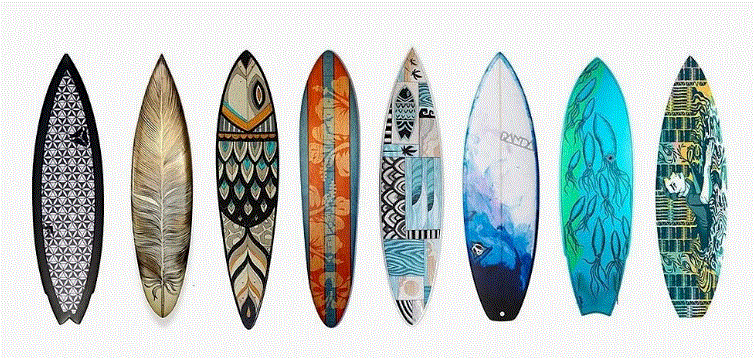Mastering the Art of Ink Blending: Tools, Techniques, and Tips

Ink blending is an exciting and versatile technique that adds stunning visual effects to your crafting projects. However, like any skill, it comes with its own set of challenges and questions. How do you achieve seamless blends for surfboard prints? What tools should you use? Which colors complement each other best? This comprehensive guide will answer all these questions and more, equipping you with the knowledge to blend like a pro.
Essential Tools for Ink Blending
Ink Blending Tool with Domed Foam Applicators
The handled blending tool, paired with a domed foam applicator, offers superior ink absorption and distribution. This thick, domed foam ensures smooth, no-line blending and is perfect for stenciling. You can either save each foam applicator for specific colors or rinse them for reuse.
Wide Blender and Scraper Craft Tool with Felt
Another revolutionary tool, the Wide Blender, features an ergonomic handle and a felt pad. Ideal for blending alcohol inks on Yupo paper as well as regular inks on cardstock, this tool’s felt pad can be washed and replaced, allowing for continued use and color versatility.
Mini Ink Blending Tool
A staple in many crafters’ toolkits, the Mini Ink Blending Tool is perfect for distressing paper, creating backgrounds, and evenly applying inks. Its smooth handle and replaceable blending foams make it easy to use and versatile. The foams absorb ink quickly, ensuring vibrant color transfer and consistent results.
Best Inks for Ink Blending
Choosing the right ink is crucial for successful ink blending. Here are some top recommendations:
Dye Inks
Dye inks are a favorite among ink-blending enthusiasts due to their affordability and ease of use. Brands like Catherine Pooler, Tim Holtz, Simon Hurley, and Lawn Fawn offer high-quality dye inks that work beautifully on white or light-colored cardstocks.
Distress Oxides
These inks are a blend of water-reactive dye and pigment ink, creating a creamy, dense formula that excels in blending. Distress Oxides sit on top of the paper, making them ideal for dark or colorful cardstock.
Hybrid Inks
Hybrid inks are designed in color families, making them perfect for seamless blends and delicate color transitions. Each color family includes four shades, allowing for stunning ombre effects.
Blending Brushes
Stencil Blending Brushes
Large-handled stencil blending brushes are ideal for bold, creative projects. Brands like Nuvo and Tim Holtz offer brushes with soft bristles for smooth blending and dusting powders. These brushes are versatile and can be used with various mediums, including pastes and mousses.
Distress Blending Brushes
With stiff, individualized bristles, these brushes achieve delicate, variegated effects. The telescoping casing allows for versatile application, spreading bristles for full coverage or tightening them for detailed work.
Cleaning Blending Brushes
Maintaining your blending brushes ensures their longevity. For dye-based and pigment inks, a gentle soap and water wash will suffice. Hybrid inks may stain the bristles, which is normal. Many crafters designate brushes for specific color families and use baby wipes or microfiber cloths for in-between cleanings.
Ink Blending Techniques
Color Combinations
Understanding color theory is key to avoiding muddy blends. Complementary colors blend beautifully, while others may create unwanted brown hues. Experiment with primary colors to discover harmonious blends.
Ink Blended Rainbow
Create a stunning rainbow with just a few primary colors. Start with red, then yellow, and blue, blending each into the next to achieve a full spectrum of colors.
Ink Blended Sunset
For a romantic sunset effect, use a palette of Mustard Seed yellow, Picked Raspberry pink, and Seedless Preserves purple, with a touch of Black Soot for depth.
Ombre Effects
To achieve an ombre look, choose 2-3 shades from the same color family. Blend from light to dark for a smooth gradient effect.
Quickstart Guide: Top Tips for Ink Blending
-
Choose the Right Tool: For soft blends, use bristle brushes. For darker saturation and coverage, opt for foam applicators.
-
Pick the Right Paper: Smooth, thick cardstock ensures the best results.
-
Use the Right Inks: Dye inks blend well on light paper, while Distress Oxides are ideal for dark and colorful cardstock.
-
Start in the Right Place: Begin blending off the paper and gradually move on your project to avoid harsh lines.
-
Start Slow: Apply ink lightly at first, adding more layers for darker results.
-
Find the Right Colors: Use a color wheel to avoid muddy blends.
-
Avoid Smudges: Use a spare piece of cardstock or cloth to prevent inky fingerprints.
-
Experiment: Practice and play with your inks to master blending techniques.
By following these tips and using the right tools and materials, you can master the art of ink blending and create stunning, professional-looking custom surfboard arts. Happy crafting!

 Enhance Your Shop Appeal with Sydney’s Best Carpentry Services
Enhance Your Shop Appeal with Sydney’s Best Carpentry Services  What Are the Top Safety Features of Automatic Close Doors?
What Are the Top Safety Features of Automatic Close Doors?  What are The Legalities of Starting a Metal Panels Business in the UAE
What are The Legalities of Starting a Metal Panels Business in the UAE  India Home Appliances Market Share, Size, Trends and Industry Report 2024-2032
India Home Appliances Market Share, Size, Trends and Industry Report 2024-2032  What Are the Best Kitchen Mats for Cold Floors?
What Are the Best Kitchen Mats for Cold Floors?  What are the Best Types of Hand Tufted Carpets?
What are the Best Types of Hand Tufted Carpets?  Exploring London’s Best Butcher Shops
Exploring London’s Best Butcher Shops  A Detailed Look at the Features of the LEGO Technic Mars Crew Exploration Rover
A Detailed Look at the Features of the LEGO Technic Mars Crew Exploration Rover